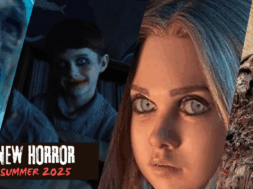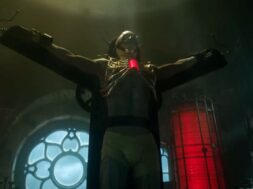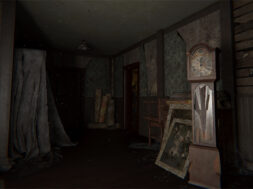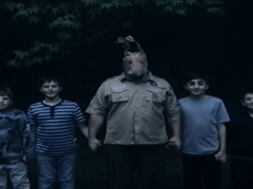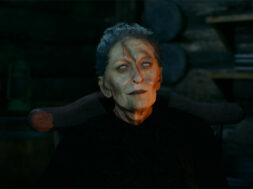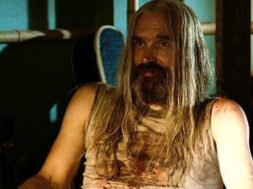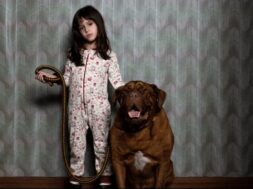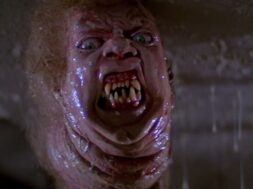You may be surprised to hear this, but a teeny-tiny movie called Halloween was released in 1978 to less than favorable reviews. Writer-director John Carpenter, along with his producing partner Debra Hill, assumed the film would quickly fade away from the public conscious soon after release. Of course, that film has gone on to become an establishment in and of itself within the horror genre, specifically the slasher film. At the time, though, it wasn’t until a reviewer at The Village Voice got their peepers on it and penned a glowing review that people really started to take notice. Based off the newfound success of Halloween, AVCO Embassy came a-knockin’. They approached the duo of Carpenter and Hill with the alluring offer of a two-picture deal. That deal gave birth to two more Carpenter classics, Escape from New York and today’s topic at hand, The Fog.
Released February 8th, 1980, The Fog is a classic tale of supernatural revenge. The waterside town of Antonio Bay is gearing up to celebrate their centennial. However, at the stroke of midnight, a glowing fog begins to roll up from the bay, and with it – the ancient spirit of pirates who were wronged many years ago. 
A Shot in The Fog
The Fog was the first film of the AVCO deal, and Carpenter’s first theatrical release since Halloween. In the interim, he stayed busy with a couple of television productions (Someone’s Watching Me!, Elvis). It was clear that Carpenter and Hill wanted to continue mining the depths of fear with their cinematic outings. And a trip to the legendary Stonehenge on a particularly foggy afternoon provided just the spark of inspiration needed for their next horror tale.
“Out in the distance, pulsating in the fields, in the bogs, was this fogbank. It was just pulsating as if there was something in it. John said, ‘What do you think’s in that – in the fog?” – Debra Hill
John’s love of old EC Comics’ style “ghosts rising back up from the grave for revenge” also played a large inspiration. This, coupled with the true story of a California town in the 19th century who would lead wayward ships to their shore with large bonfires in order to loot the ship’s bounty, all melded together to form The Fog.
The film was given a budget of around $1 million with a cast of Carpenter regulars. At this time, Hill and Carpenter were no longer romantically involved. In fact, he was married to Stevie Wayne actress Adrienne Barbeau. The two met while filming 78’s Someone’s Watching Me. Tom Atkins (Night of the Creeps, My Bloody Valentine 3D) began his working relationship with the director here. He popped again in the following year’s Escape from New York and another Stonehenge inspired production, Halloween III: Season of the Witch. Next to Barbeau and Atkins, there was, of course, Jamie Lee Curtis. Curtis was still hot off her starring role in Halloween and would be seen on the silver screen for two other 1980 fright flicks, Terror Train (a personal favorite) and Prom Night. While “Scream Queen” may not be the most prestigious title, it’s clear from an interview Curtis gave at the time while promoting The Fog, just why she was considered THE Scream Queen de jour:
“In a horror film you start out usually very normal, like a normal person. And you end up being a terrorized individual – and everything in between there. So, you have all this range to play. You go from happy to sad to crying, hysterical. Your smarts come back in. Determination. Bravery. And all those things come into a horror film if you’re the person who inevitably gets terrorized. It enables you to show your stuff in a very broad sense. “
On the production side, there were several familiar faces from the Halloween crew as well. Tommy Lee Wallace acted as both editor and production designer and would go on to direct Halloween III. The cinematography was handled by the one and only Dean Cundey. They were both key in breathing life into the “pulsating” fog. Various techniques were used to bring character into the ominous mist. For wide shots of the fog creeping down streets and across various buildings, shots were filmed first without any fog in sight. They would then photograph scaled down black sculptures which imitated the shapes of the buildings and aim dry ice towards them. This would allow the vapor to weave itself in around the structures organically while still providing more control (especially in terms of lighting) than if they just funneled mist onto the set. This would then be superimposed over the original footage. The final effect is seamless and puts to shame any CGI techniques that would undoubtedly be used today. For moments where the fog needed to appear as if it were retreating, they would simply have the cast act in reverse. This meant they had to be extremely careful of their body movements (including how they blinked!) to ensure the final shot looked natural.
Releasing The Fog
Upon viewing a rough cut of the film, John Carpenter was worried. He felt the film just simply didn’t work. The heads of AVCO agreed. They didn’t feel there was enough terror.
“We felt like we needed to go back in to emphasize certain things that would make it – that would raise the stakes in terms of the horror and the terror.” – Debra Hill
With a limited amount of time before the set release date, the crew went back into film a boatload of extra scenes. The opening scene of the ghost story told ’round the fire was a new addition as well. It’s an important moment that sets the tone perfectly for the spooky tale that follows. The Fog is exactly the type of film that would seem far too terrifying to us when we were kids. It’s outlandish yet simple tale of revenge from beyond the grave that carries the type of imagery that’s instantly recognizable no matter your age or background.
The chase up the lighthouse as the pirates slowly circle in on Stevie Wayne was probably the most involved reshoot as it required so many moving parts in regards to the effects, stunts, and choreography. The gore quotient was boosted considerably as well. They realized that horror had come a long way since Halloween’s release two years prior. Merely insinuating a death wasn’t going to be up to snuff for a 1980’s audience. The blood needed to flow.
In terms of marketing, a poster was made that heavily featured Jamie Lee struggling to fight off the supernatural entity behind a heavy door, a pirate’s rotted hand reaches through to grab her. Hill and Carpenter didn’t necessarily feel this was representative of the film as, obviously, Curtis wasn’t the star, Barbeau was. Another ploy from the marketing department saw AVCO shipping fog machines to numerous theaters across the country. Much like William Castle’s various ballyhoo stunts from the 50’s, theater owners would pipe the fog into the auditorium for maximum immersive effect. Whether the draw of Curtis or Carpenter’s names did the trick or the trailer’s promise of “the ultimate experience in terror and suspense,” The Fog was a hit. Around $21 million washed up from the film’s box office.
The critics weren’t so favorable, however. Roger Ebert was notoriously hard on more violent horror films of the 80’s. Despite being a huge fan of Carpenter’s Halloween, he was none too impressed with the director’s follow-up.
“But when the sailors’ ghosts return, wrapped in fog, we can’t figure out what their motives are. Do they want to kill the descendants of their murderers?” An answer to this question can be found in the film’s novelization, and the answer is “yes.” Ebert continues, “Are they angry at the town itself? Are they indeed there in the fog, or are their victims hallucinating?…A sentient fog may be photogenic (and this is a good-looking movie), but can we identify with it? Is it the kind of villain we love to hate? Not really.” – Roger Ebert, Chicago Sun-Times
A poor critical reception isn’t much of a surprise considering it happened at first with Halloween before a few influential people decided otherwise, and we all know what went down with The Thing and how it was initially ravaged by critics upon release. Now 38 years later, it’s safe to say that The Fog is another surefire classic amongst the filmography of one of our greatest Masters of Horror. It’s a campfire tale brought to vivid life on screen that carries the perfect sense of a time gone by, when the mere mention of a waterlogged ghost rising from the ocean’s depths to seek revenge would be enough to keep you wide awake in fear all night long.


